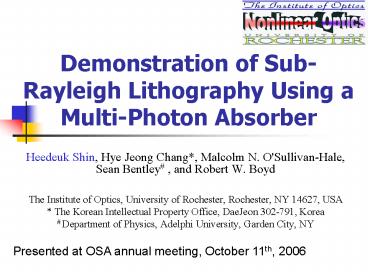Demonstration of SubRayleigh Lithography Using a MultiPhoton Absorber PowerPoint PPT Presentation
1 / 19
Title: Demonstration of SubRayleigh Lithography Using a MultiPhoton Absorber
1
Demonstration of Sub-Rayleigh Lithography Using
aMulti-Photon Absorber
- Heedeuk Shin, Hye Jeong Chang, Malcolm N.
O'Sullivan-Hale, Sean Bentley , and Robert W.
Boyd - The Institute of Optics, University of Rochester,
Rochester, NY 14627, USA - The Korean Intellectual Property Office,
DaeJeon 302-791, Korea - Department of Physics, Adelphi University,
Garden City, NY
Presented at OSA annual meeting, October 11th,
2006
2
Outline
- Motivation
- Quantum lithography
- Proof-of-principle experiments
- Multi-photon lithographic recording material
- Experimental results
- Non-sinusoidal 2-D patterns
- Conclusion future work
1/16
3
Motivation
- In optical lithography, the feature size is
limited by diffraction, called the Rayleigh
criterion. - - Rayleigh criterion l/2
- Quantum lithography using an N-photon
lithographic recording material entangled light
source was suggested to improve optical
lithography. - We suggest PMMA as a good candidate for an
N-photon lithographic material.
2/16
4
Quantum lithography
- Classical interferometric lithography
- - , where K
l/(2sinq) - Resolution l/2 at grazing incident angle
- Quantum interferometric lithography uses
entangled N-photon light source. - -
- Resolution l/2N
- Advantage high visibility is possible even with
large resolution enhancement.
Boto et al., Phys. Rev. Lett. 85, 2733, 2000
3/16
5
Enhanced resolution with a classical light source
Phase-shifted-grating method
- Fringe patterns on an N-photon absorber with M
laser pulses. - The phase of mth shot is given by 2pm/M.
- The fringe pattern is
- Example
One photon absorber Single shot
Two-photon absorber Two shots
S.J. Bentley and R.W. Boyd, Optics Express, 12,
5735 (2004)
4/16
6
PMMA as a multi-photon absorber
- PMMA is a positive photo-resist, is transparent
in visible region and has strong absorption in UV
region. - 3PA in PMMA breaks chemical bonds, and the broken
bonds can be removed by developing process. (N
3 at 800 nm)
PMMA is excited by multi-photon absorption
800 nm
UV absorption spectrum of PMMA
5/16
7
Experiment material preparation
- Sample preparation
- 1) PMMA solution
- PMMA (Aldrich, Mw 120,000)
Toluene 20 wt - 2) PMMA film Spin-coat on a glass substrate
- Spin coating condition 1000 rpm, 20
sec, 3 times - Drying 3 min. on the hot plate
- Development
- 1) Developer 11 methyl isobutyl ketone
(MIBK) to Isopropyl Alcohol - 2) Immersion 10 sec
- 3) Rinse DI water, 30 sec
- 4) Dry Air blow dry
6/16
8
Experimental setup
with regenerative amplifcation 120 fs, 1 W, 1
kHz, at 800 nm (Spectra-Physics)
WP half wave plate Pol. polarizer M1,M2,M3
mirrors BS beam splitter f1,f2 lenses PR
phase retarder (Babinet-Soleil compensator)
7/16
9
Experimental process
Path length difference l/2
Interference pattern shifted by l/4
Developing
l/2
Phase retarder
l/4
PMMA
Substrate (Glass)
8/16
10
Demonstration of writing fringes on PMMA
Recording wavelength 800 nm Pulse energy 130
mJ per beam Pulse duration 120 fs
Recording angle, ? 70 degree Period ?/(2sin?)
425 nm
425 nm
9/16
11
Sub-Rayleigh fringes l/4 (M 2)
Recording wavelength 800 nm Two pulses with
phase shift Pulse energy 90 mJ per beam
Pulse duration 120 fs Recording angle, ? 70
degree Fundamental period ?/(2sin?) 425
nm Period of written grating 213 nm
p
213 nm
10/16
12
Threefold enhanced resolution (M 3)
Recording wavelength 800 nm Three pulses
with 2p/3 4p/3 phase shift Pulse energy 80 mJ
per beam Pulse duration 120 fs Recording
angle, ? 8.9 degree Fundamental period
?/(2sin?) 2.6 mm Period of written grating
0.85 mm
0.8 mm
1.67 mm
213 nm
2.6 mm
11/16
13
Non-sinusoidal fringes
- PMMA is a 3PA at 800 nm. (N3)
- Illumination with two pulses. (M2)
- If the phase shift of the second shot is
- , where ,
- the interference fringe is
- Numerical calculation is similar to the
experimental result. - This shows the possibility of non-sinusoidal
fringe patterns.
12/16
14
Non-sinusoidal Patterns
- Different field amplitudes on each shot can
generate more general non-sinusoidal patterns.
For example, if N 3 , M 3 A1 1
A2 0.75 A3 0.4
?1 0 ?2 p/2 ?3 p
13/16
15
Two Dimensional Patterns
- Method can be extended into two dimensions using
four recording beams.
For example, N8, M14
14/16
16
Conclusion
- The possibility of the use of PMMA as a
multi-photon lithographic recording medium for
the realization of quantum lithography. - Experimental demonstration of sub-Rayleigh
resolution by means of the phase-shifted-grating
method using a classical light source. - - writing fringes with a period of l/4
- Quantum lithography (as initially proposed by
Prof. Dowling) has a good chance of becoming a
reality. - Future work
- Higher enhanced resolution (M 3 or more)
- Build an entangled light source with the high
gain optical parametric amplification. - Realization of the quantum lithography method.
15/16
17
Acknowledgement
Dr. Samyon Papernov
Supported by - the US Army Research Office
through a MURI grant - the Post-doctoral
Fellowship Program of Korea Science and
Engineering Foundation (KOSEF) and Korea
Research Foundation (KRF)
16/16
18
Thank you for your attention! http//www.optics.
rochester.edu/boyd
19
Two Dimensional Patterns
- Experimental 2-D pattern
- Illuminate one shot, N 3, M 1
- Rotate the sample
- Illuminate the second shot, N 3, M 1

